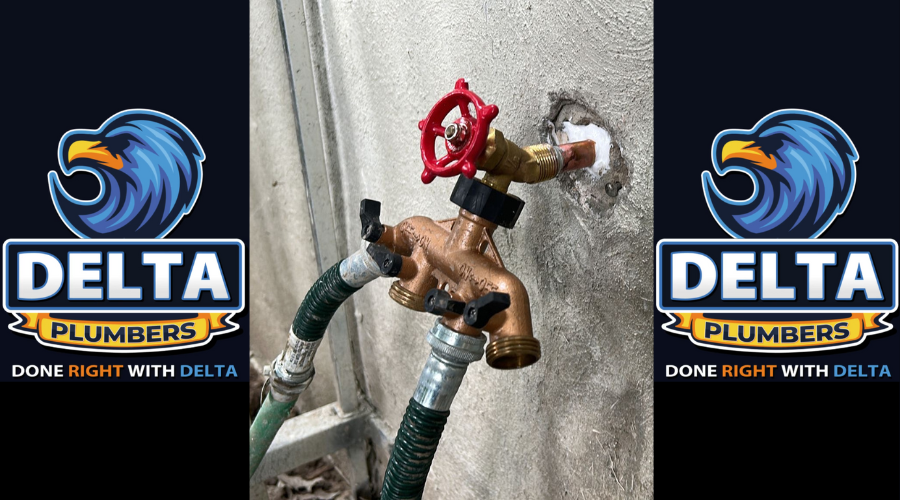When you’re dealing with a leaking hose bib, it’s more than just an annoyance. Even minor leaks from an outdoor spigot can lead to water wastage, costly utility bills, and potential structural damage to your home if left unchecked. This guide by Delta Plumbers will walk you through the most common methods on how to fix a leaking hose bib, helping you restore its efficiency and prevent future leaks.

Picture Source – Delta Plumbers
How to Stop a Hose Bib from Leaking
The first step in addressing a leaking hose bib is understanding why it’s leaking. There are several common reasons, including loose connections, worn-out washers, faulty valves, or even freezing damage from colder months. Here’s how you can identify and tackle each cause:
1. Turn Off the Water Supply
Before you begin any repair, locate the shut-off valve connected to your outdoor spigot and turn off the water supply. This prevents any unwanted water flow during the repair process and ensures you can work safely without flooding the area.
2. Inspect the Packing Nut
A frequent cause of hose bib leaks is a loose packing nut located behind the handle. Using a wrench, try tightening the nut slightly; in many cases, this simple action can stop a leak. If the leak persists, proceed to the next steps.
3. Replace the Washer
Another common issue is a worn-out washer. To check and replace the washer, unscrew the handle and stem from the hose bib, exposing the washer inside. Remove the old washer and replace it with a new one that matches the size and style. Once replaced, reassemble the hose bib and test for leaks.
4. Use a Hose Bib Repair Kit
If tightening the packing nut and replacing the washer doesn’t stop the leak, you may want to try a hose bib repair kit. These kits contain various components that can help seal and repair the spigot effectively, ensuring a tight fit and preventing further leaks.
Each of these steps will help prevent minor leaks and maintain the integrity of your hose bib. If, however, the leak continues after these repairs, you may have more complex plumbing issues that require professional assistance.
Also Read: Professional Drain Cleaning Service: Benefits and More

Picture Source – Delta Plumbers
Can a Hose Bib Be Repaired?
Yes, in many cases, a hose bib can be repaired rather than replaced entirely. Whether a hose bib needs repair or replacement generally depends on the severity and cause of the leak. Minor issues, such as a loose connection or a damaged washer, can usually be resolved with simple repairs. Here are the most common repair solutions and when each is applicable:
1. Tightening Loose Components
If your hose bib has loose connections or threads, simply tightening them can resolve the leak. This approach is usually the easiest and quickest repair option.
2. Adjusting or Replacing the Packing Nut
The packing nut, which prevents water from escaping around the valve stem, may become loose over time. By tightening or replacing this nut, you can often stop leaks that originate from this area.
3. Using Replacement Parts
Some hose bibs are designed to accommodate replacement parts, such as washers, seals, and even stems. If you’re comfortable dismantling and reassembling plumbing parts, swapping out these components can provide a lasting solution.
4. When to Replace Instead of Repair
If the hose bib body itself is cracked or if the pipe behind it is damaged, a replacement might be more cost-effective. Severe rust, corrosion, or extensive wear and tear on the fixture’s core structure can also indicate that it’s time for a new hose bib.
In many situations, with the right tools and a bit of patience, hose bibs can be repaired. However, for complicated issues or hard-to-reach spigots, consulting a professional plumber may be the best solution.
Also Read: Repair a Leaking Water Heater: How to Do it?

Picture Source – Delta Plumbers
How Do You Seal a Leaking Spigot?
Sealing a leaking spigot is often necessary if you notice water seeping around the connections or threads. There are a few effective techniques to ensure a watertight seal, and they are essential to preventing further leaks.
1. Applying Teflon Tape
Teflon tape, also known as plumber’s tape, is a widely used material for sealing threaded connections. Wrap the tape around the threads clockwise (following the direction of threading) to ensure a tight and secure fit.
2. Using Silicone-Based Sealants
Silicone-based sealants provide a waterproof and flexible seal. Apply the sealant around the base of the hose bib where it connects to the wall or pipe. Allow the sealant to cure according to the manufacturer’s instructions before turning on the water.
3. Adding Plumber’s Putty
Plumber’s putty can be applied around the base of the spigot to seal minor leaks effectively. Unlike Teflon tape, which is used on threads, plumber’s putty is applied externally to create a water-resistant seal. After applying, wait for it to harden before testing the hose bib.
By following these steps, you’ll be able to seal leaks effectively. Be sure to choose the right material for your specific leak and adhere to the instructions provided by the product manufacturers for optimal results.
Also Read: Benefits of Installing a Water Softener

Picture Source – Delta Plumbers
How Much Does It Cost to Fix a Leaking Hose Bib?
Repair costs for a leaking hose bib can vary depending on the type of repair, location, and whether you choose to DIY or hire a professional. Here’s a breakdown of potential expenses:
1. DIY Repair Costs
For those comfortable with tools, repairing a hose bib yourself can be an affordable option. The basic materials—Teflon tape, washers, and a wrench—typically cost between $5 and $15. If you require additional tools or a hose bib repair kit, the price can rise to around $20–$30.
2. Professional Repair Costs
Hiring a plumber can offer peace of mind and ensure the job is done correctly, especially for complicated repairs. On average, professional repair fees range from $75 to $150, depending on labor costs, materials, and the specific nature of the leak.
3. Replacement Costs
If repair is not an option, replacing the hose bib may cost around $50–$100 for the part alone, with labor fees adding $50–$100 more if you choose to hire a professional. Some high-end or frost-proof hose bibs may increase this range slightly.
While DIY repairs are often the most economical, investing in professional assistance can save time and avoid costly mistakes if you’re unsure about tackling the repair on your own.
Also Read: How to Install New Kitchen Faucet: Delta Plumbers

Picture Source – Delta Plumbers
What Do You Use to Seal a Hose Bib?
When it comes to sealing a hose bib, the right materials make all the difference in achieving a durable, leak-free connection. Here’s an overview of the most commonly used sealing materials:
1. Teflon Tape
Teflon tape is a popular choice because of its flexibility and ease of application. It is most effective for threaded connections, where it can be wrapped around the male threads before the hose bib is screwed into place.
2. Plumber’s Putty
Plumber’s putty is ideal for sealing joints and areas around the base of the hose bib. Unlike Teflon tape, which is used on threads, plumber’s putty is applied externally to create a water-resistant seal.
3. Gasket Material
In some cases, using a rubber or neoprene gasket can provide an additional layer of protection against leaks. Gaskets are particularly useful if you’re dealing with non-threaded connections.
Using these materials effectively requires a basic understanding of where the leak is originating from. Choose the material that best suits your hose bib’s configuration to ensure a secure and watertight seal.
Conclusion
Fixing a leaking hose bib is a simple task that can prevent water waste, reduce utility costs, and avoid structural issues. Whether the problem is a loose nut, a worn washer, or a faulty seal, the right tools and techniques can often resolve the leak quickly. Basic fixes, like tightening connections or applying Teflon tape, can work well for minor leaks, while replacement may be best for severe damage. Regular maintenance, especially after colder months, can help prevent future issues. If the repair seems too complex, Delta Plumbers is here to provide professional help, ensuring your hose bib operates efficiently and leak-free.









